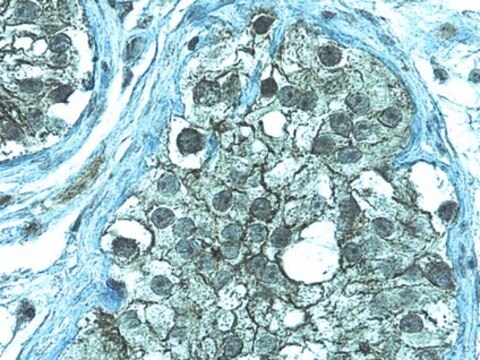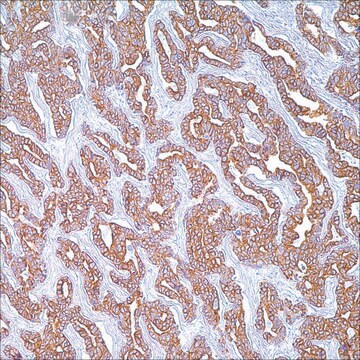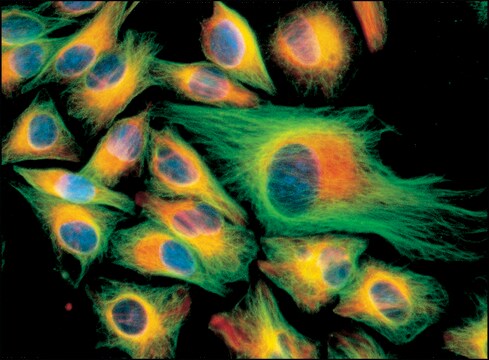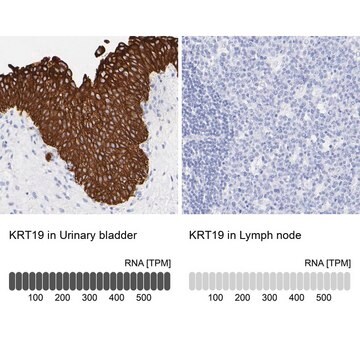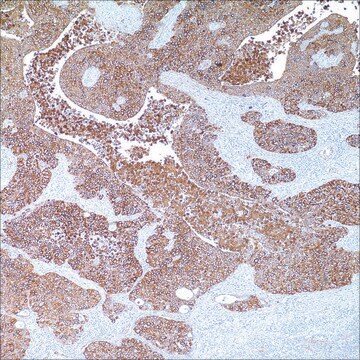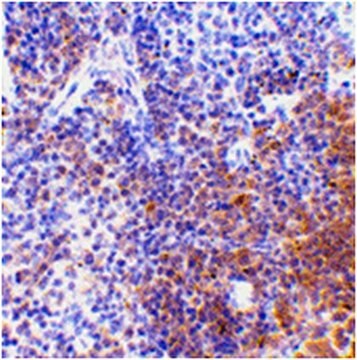MAB3412
Anti-Cytokeratin AE1/AE3 Antibody, recognizes acidic & basic cytokeratins, clone AE1/AE3
clone AE1/AE3, Chemicon®, from mouse
Sinonimo/i:
Pan cytokeratin
About This Item
Prodotti consigliati
Origine biologica
mouse
Livello qualitativo
Forma dell’anticorpo
purified antibody
Tipo di anticorpo
primary antibodies
Clone
AE1/AE3, monoclonal
Reattività contro le specie
chicken, mouse, monkey, human, rabbit, bovine, rat
Produttore/marchio commerciale
Chemicon®
tecniche
ELISA: suitable
immunohistochemistry: suitable
western blot: suitable
Isotipo
IgG1
Condizioni di spedizione
wet ice
modifica post-traduzionali bersaglio
unmodified
Informazioni sul gene
bovine ... Krt1(100301161)
human ... KRT1(3848)
mouse ... Krt1(16678)
rat ... Krt1(300250)
Descrizione generale
Specificità
Immunogeno
Applicazioni
A previous lot of this antibody was used for ELISA (Woodcock-Mitchel & Sun, 1982).
Western blot:
(Woodcock-Mitchel & Sun, 1982; Tseng et al., 1982; Laster et al., 1986) ELISA: (Woodcock-Mictchel & Sun, 1982)
Immunohistochemistry(paraffin):
0.5-2 µg/mL of a previous lot was used on staining of unfixed frozen or formalin -fixed, paraffin-embedded tissue section (Woodcock-Mitchel & Sun, 1982; Tseng et al., 1982; Asch * Asch, 1986; Rodriguez et al., 1986; Clausen et al., 1986; Klein-Szanto et al., 1987; Reibel et al., 1985). Trypsin or pepsin digestion is required for proper staining on paraffin embedded tissues. {Trypsin 1 mg/mL 10 minutes, 37°C, or pepsin 1 mg/mL 5 minutes 37°C}. High temperature with citrate antigen retrieval can also be used.
Optimal dilutions must be determined by end user.
Cell Structure
Cytokeratins
Qualità
Western blot:
1:500 dilution of this lot detected CYTOKERATIN AE1/AE3 on 10 μg of A431 lysates.
Descrizione del bersaglio
Stato fisico
Stoccaggio e stabilità
DO NOT FREEZE.
Risultati analitici
All epithelium-derived tissues & tumors
Altre note
Note legali
Esclusione di responsabilità
Non trovi il prodotto giusto?
Prova il nostro Motore di ricerca dei prodotti.
Avvertenze
Danger
Indicazioni di pericolo
Consigli di prudenza
Classi di pericolo
Repr. 1B
Codice della classe di stoccaggio
6.1D - Non-combustible acute toxic Cat.3 / toxic hazardous materials or hazardous materials causing chronic effects
Classe di pericolosità dell'acqua (WGK)
WGK 1
Punto d’infiammabilità (°F)
Not applicable
Punto d’infiammabilità (°C)
Not applicable
Certificati d'analisi (COA)
Cerca il Certificati d'analisi (COA) digitando il numero di lotto/batch corrispondente. I numeri di lotto o di batch sono stampati sull'etichetta dei prodotti dopo la parola ‘Lotto’ o ‘Batch’.
Possiedi già questo prodotto?
I documenti relativi ai prodotti acquistati recentemente sono disponibili nell’Archivio dei documenti.
Articoli
16HBE14o- human bronchial epithelial cells used to model respiratory epithelium for the research of cystic fibrosis, viral pulmonary pathology (SARS-CoV), asthma, COPD, effects of smoking and air pollution. See over 5k publications.
Il team dei nostri ricercatori vanta grande esperienza in tutte le aree della ricerca quali Life Science, scienza dei materiali, sintesi chimica, cromatografia, discipline analitiche, ecc..
Contatta l'Assistenza Tecnica.